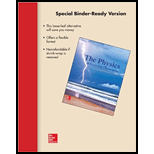
(a)
The time taken by each ball to reach the floor.
(a)
Answer to Problem 3SP
The time taken by each ball to reach the floor is
Explanation of Solution
Given info: The height of the table top is equal to
Consider the motion of the ball
Therefore, Write the equation of vertical distance travelled by the both the balls.
Here,
In the case of ball the only vertical acceleration is the acceleration due to gravity and distance travelled by the ball is equal to the height of the table.
Substitute
Therefore, the time taken by both the balls are equal to
Conclusion:
Thus, time taken by both the balls to reach the ground is
(b)
The horizontal distance travelled by the balls before hitting the floor.
(b)
Answer to Problem 3SP
Before hitting the ground ball A travelled a horizontal distance of
Explanation of Solution
Given info: the horizontal velocity of ball A is
Consider the motion of the ball
Therefore, write the equation of horizontal distance of the ball A.
Here,
Substitute
Consider the motion of the ball B. In horizontal direction there is no acceleration.
Therefore, write the equation of horizontal distance of the ball B.
Here,
Substitute
Conclusion:
Thus, before hitting the ground ball A travelled a horizontal distance of
(c)
Whether the two balls will reach the floor at same time, if the two balls started at the same time at a point
(c)
Answer to Problem 3SP
Since the ball B has larger velocity than ball A, ball B will reach the edge of the table first and therefore A will reach the floor first.
Explanation of Solution
Given info: The distance behind the edge at which the balls are started rolling is
In part a, it is showed that both the ball will reach the ground at the same time if they are allowed to roll off the balls at the table top.
But in this case they are started rolling at same time at a point
Therefore, write the equation of horizontal distance of the ball A.
Rearrange the above equation to get
Substitute
Write the equation of horizontal distance of the ball B.
Rearrange the above equation to get
Substitute
Therefore ball B has taken less time than ball A to cover
Conclusion:
Since the ball B has larger velocity than ball A, ball B will reach the edge of the table first and therefore A will reach the floor first.
Want to see more full solutions like this?
Chapter 3 Solutions
Physics of Everyday Phenomena (Looseleaf)
 College PhysicsPhysicsISBN:9781305952300Author:Raymond A. Serway, Chris VuillePublisher:Cengage Learning
College PhysicsPhysicsISBN:9781305952300Author:Raymond A. Serway, Chris VuillePublisher:Cengage Learning University Physics (14th Edition)PhysicsISBN:9780133969290Author:Hugh D. Young, Roger A. FreedmanPublisher:PEARSON
University Physics (14th Edition)PhysicsISBN:9780133969290Author:Hugh D. Young, Roger A. FreedmanPublisher:PEARSON Introduction To Quantum MechanicsPhysicsISBN:9781107189638Author:Griffiths, David J., Schroeter, Darrell F.Publisher:Cambridge University Press
Introduction To Quantum MechanicsPhysicsISBN:9781107189638Author:Griffiths, David J., Schroeter, Darrell F.Publisher:Cambridge University Press Physics for Scientists and EngineersPhysicsISBN:9781337553278Author:Raymond A. Serway, John W. JewettPublisher:Cengage Learning
Physics for Scientists and EngineersPhysicsISBN:9781337553278Author:Raymond A. Serway, John W. JewettPublisher:Cengage Learning Lecture- Tutorials for Introductory AstronomyPhysicsISBN:9780321820464Author:Edward E. Prather, Tim P. Slater, Jeff P. Adams, Gina BrissendenPublisher:Addison-Wesley
Lecture- Tutorials for Introductory AstronomyPhysicsISBN:9780321820464Author:Edward E. Prather, Tim P. Slater, Jeff P. Adams, Gina BrissendenPublisher:Addison-Wesley College Physics: A Strategic Approach (4th Editio...PhysicsISBN:9780134609034Author:Randall D. Knight (Professor Emeritus), Brian Jones, Stuart FieldPublisher:PEARSON
College Physics: A Strategic Approach (4th Editio...PhysicsISBN:9780134609034Author:Randall D. Knight (Professor Emeritus), Brian Jones, Stuart FieldPublisher:PEARSON





